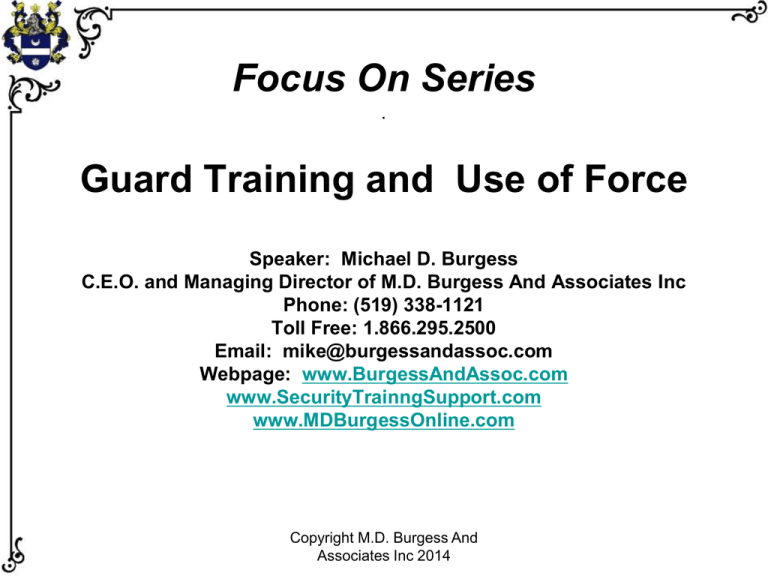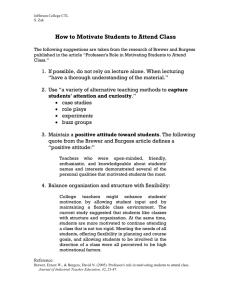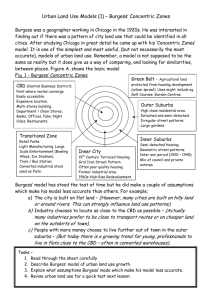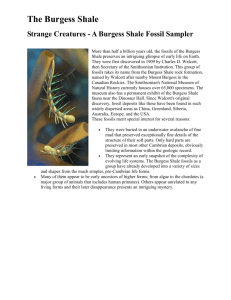Guard Training and Use of Force - Mike Burgess
advertisement

Focus On Series . Guard Training and Use of Force Speaker: Michael D. Burgess C.E.O. and Managing Director of M.D. Burgess And Associates Inc Phone: (519) 338-1121 Toll Free: 1.866.295.2500 Email: mike@burgessandassoc.com Webpage: www.BurgessAndAssoc.com www.SecurityTrainngSupport.com www.MDBurgessOnline.com Copyright M.D. Burgess And Associates Inc 2014 Overview Where are we now? The pain of the past and the impact today. Change is Inevitable. How to avoid getting “blindsided” by it. Problems with Due Diligence and “Best Practices” Training and the realities of modern security. Copyright M.D. Burgess And Associates Inc 2014 The Challenges “Audits/reviews of security operations.” Who should do them, how should they be done, where do you get input, what is valid and what is not? Implementing Change - Who should be trained, how should this be done and to what standard? Accountability – To who and for what reasons? How do we “Lead in Times of Rapid Change?” Copyright M.D. Burgess And Associates Inc 2014 You don’t keep your habits…. …your habits keep you. Definition of insanity: Doing the same thing over and over again… (because that’s the way its always been done,) …then expecting a different result. Copyright M.D. Burgess And Associates Inc 2014 Where are you now? “The Pain of the Past.” “Know thyself.” - Plato. Evidence of the pain? 1. The “Shand” case, Asante Mensah case 2. Insurance companies demanding more due diligence. Vetting of certificates and programs are the new norm. 3. New Provincial Legislation & Regulations enacted that clashed with previous policies and challenged previous training programs. 4. Lack of mandatory refresher/recertification in core competency skill sets for security. (Academic and physical intervention –specialty skills.) 5. Lack of standardization of training programs. Copyright M.D. Burgess And Associates Inc 2014 Problems with “Best Practices” Christopher Columbus and his paradigm in 1492. Columbus believed that if he sailed west he would arrive in India. His actions flowed from his view of the world. Was it contrary to the rest of the world at the time? His greatest challenge? Recruiting crew. “Best practice at the time was… Copyright M.D. Burgess And Associates Inc 2014 Problems with “Best Practices” “Best practices” cannot be simply transported from one location or company to another, nor one country or one sector to another then applied in ‘cookie-cutter’ fashion. FACT: Police practices are not always valid in the security work environment no more than the practices of a busy mall can be applied to a quiet one. What may be “court/medically acceptable in the U.S. is not always acceptable here. Copyright M.D. Burgess And Associates Inc 2014 Problems with “Best Practices” Many of the “processes” being championed are examples of successful practice, but they are far from best practice. There is no room for blind ignorance in our field, the stakes are too high. ‘Best practice’ does not really exist. What we rely on to heavily is more appropriately called “successful practice”…but remember this; BEST PRACTICES ARE NOT LAW! In a courtroom and under the legal microscope, case law and legislation trumps “best practices” every time. Copyright M.D. Burgess And Associates Inc 2014 Problems with current “Best Practices” Available Training vs. The Realities of Modern Security FACT: There is currently an “academics only” approach by the Provincial licensing bodies in Canada. There is still, as of today, except in B.C., no mandatory requirement for physical skills/use of force or handcuff training. Worse, there is no requirement for “refresher” or “re-certification” testing in order to renew a security guard license. Copyright M.D. Burgess And Associates Inc 2014 Problems with “Best Practices.” Available “Training” vs. The Realities of Modern Security FACT: Certificates without substance will not withstand court scrutiny. Programs without course training standards and appropriate evaluation processes, and/or without Canadian vetted instructor credentials, is like handing a blank cheque to a good litigation lawyer. BEWARE OF CERTIFICATE COLLECTORS!. Copyright M.D. Burgess And Associates Inc 2014 “The Solution” “Those who do not learn the lessons of the past, are destined to repeat them.” Due Diligence Warning: One civil case could have paid for your all training programs and time spent on due diligence for years! Copyright M.D. Burgess And Associates Inc 2014 “The Challenge” “If the ship misses the harbour it is seldom the harbours fault.” Leading through Times of Change. Working within new paradigms. How do you fill the gaps you identify? “Nothing inspires genius and creative thinking like a tight budget and new mandatory standards.” Mike Burgess, M. D. Burgess And Associates Inc. Copyright M.D. Burgess And Associates Inc 2014 Legal Update Arrest and the Use of Force Amendments to the Criminal Code Sections on Citizen's Arrest, Defences of Property and Persons. Short Title: Citizen's Arrest and Selfdefence Act Royal Assent Granted June 28, 2012 Copyright M.D. Burgess And Associates Inc 2014 Overview of what was replaced. The Citizen’s Arrest and Self-defence Act C-26 has replaced the present Criminal Code sections 34 to 42: Self-defence against unprovoked assault (s.34), Self-defence in case of aggression (s.35), Provocation (s.36), Preventing Assault (s.37), Defence of personal property (s.38), Defence with claim of right (s.39), Defence of dwelling (s.40), Defence of house or real property (s.41), and Assertion of right to house or real property (s.42). with the new Defence of Persons (s.34) and Defence of Property (s.35). The Citizen’s Arrest and Self-defence Act also has amended s. 494(2) of the Criminal Code. (Citizen’s Copyright M.D. Burgess Andarrest on or in relation to Associates Inc 2014 property.) Amendments to C.C. 494(2) New section 494(2) reads: The owner or a person in lawful possession of property, or a person authorized by the owner or by a person in lawful possession of property, may arrest a person without a warrant if they find them committing a criminal offence on or in relation to that property and (a) they make the arrest at that time; or (b) they make the arrest within a reasonable time after the offence is committed and they believe on reasonable grounds that it is not feasible in the circumstances for a peace officer to make the arrest. Copyright M.D. Burgess And Associates Inc 2014 Amendments to C.C. 494(2) 1. What is a “reasonable time” after the offence is committed? 2. What are “reasonable grounds for believing that it is not feasible in the circumstances” for a peace officer to make the arrest? The amendment does not provide specific answers, however…. Copyright M.D. Burgess And Associates Inc 2014 Effect on Security Personnel & Operations Security guards are NOT given the power to arrest on “reasonable grounds” by the amendment. The amendments does NOT broaden the powers of arrest of security guards and make their powers similar to that of a peace officer under section 495 by permitting an arrest on reasonable grounds at some point later. Copyright M.D. Burgess And Associates Inc 2014 Effect on Security Personnel & Operations The amendment is restricted to criminal offences “on or in relation to property.” “On or in relation to property is about impact not geography. Many guards become overly paranoid about property boundary lines when they need to be more cognizant of the impact the event is having on the people coming and going from the property they are Copyright M.D. Burgess And guarding.” Associates Inc 2014 Effect on Security Personnel & Operations This also does NOT alter/impact the definitions of “fresh pursuit.” This issue of “fresh pursuit” and assisting other security/loss prevention personnel with their arrests, is another situation that attracts unnecessary liability. Copyright M.D. Burgess And Associates Inc 2014 Effect on Security Personnel & Operations The amendment does not change the definition of “finds committing” in s. 494. It does not, nor ever has, equated the “real time” viewing of a crime-inprogress on a CCTV surveillance system with the eyewitness viewing of the crime at, or near, the crime scene by a security guard. Guards must witness criminal offences in person in order to effect an arrest. CCTV cameras do NOT give security “reasonable grounds” for arrest. Police can make arrests using CCTV alone, however security cannot. Copyright M.D. Burgess And Associates Inc 2014 The Effect of the Changes to the Criminal Code Use of Force sections/authorities on Security Operations & Training. Copyright M.D. Burgess And Associates Inc 2014 The Citizen’s Arrest and Self-defence Act replaced Criminal Code sections 34 to 42. All these sections have been repealed and replaced. Self-defence against unprovoked assault (s.34), Self-defence in case of aggression (s.35), Provocation (s.36), Preventing Assault (s.37), Defence of personal property (s.38), Defence with claim of right (s.39), Defence of dwelling (s.40), Defence of house or real property (s.41), and Assertion of right to house or real property (s.42). Copyright M.D. Burgess And Associates Inc 2014 Plainly said, the change place authorities into two broad sections; defence of people and defence of property. The “right of response,” is not an unlimited one. A person who uses force must do so in a measured way that is necessary and proportionate to the threat. Only an amount of force that is “reasonable in all the circumstances” can be justified....and now you must fully explain what you have done and why, or else! The days of “as much force as necessary” and “one level higher,” force plus one,” etc are all relics of the past and no longer acceptable in most situations the security world. Copyright M.D. Burgess And Associates Inc 2014 DEFENCE OF PEOPLE Under the new legislation, section 34, Defense of People, is now a reverse onus situation. Persons will NOT be guilty of an offence if: 1. They believe on reasonable grounds that force, or a threat of force, is being used against them or someone else, 2. The actions that constitute the offence are committed for the purpose of defending or protecting themselves or the other person AND 3. The act committed is reasonable in all the circumstances. Copyright M.D. Burgess And Associates Inc 2014 34(2) In determining whether the act committed is reasonable in the circumstances, the court shall consider, among other factors, (a) the nature of the force or threat; (b) the extent to which the use of force was imminent and whether there were other means available to respond to the potential use of force; (c) the person’s role in the incident; (d) whether any party to the incident used or threatened to use a weapon; Copyright M.D. Burgess And Associates Inc 2014 34(2) In determining whether the act committed is reasonable in the circumstances, the court may consider, among other factors, (e) the size, age, gender and physical capabilities of the parties thereto; (f) the nature, duration and history of any relationship between the parties to the incident, including any prior use or threat of force and the nature of that force or threat; any history of interaction or communication between the parties to the incident, (g) the nature and proportionality of the person’s response to the use or threat of force; and (h) whether the act committed was in response to a use or threat of force that the person knew was lawful. Copyright M.D. Burgess And Associates Inc 2014 DEFENCE OF PROPERTY 35. (1) A person is not guilty of an offence if (a) they either believe on reasonable grounds that they are in peaceable possession of property or are acting under the authority of, or lawfully assisting, a person whom they believe on reasonable grounds is in peaceable possession of property; (b) they believe on reasonable grounds that another person (i) is about to enter, is entering or has entered the property without being entitled by law to do so, (ii) is about to take the property, is doing so or has just done so, or (iii) is about to damage destroy the property, or make it Copyrightor M.D. Burgess And Associatesso; Inc 2014 inoperative, or is doing DEFENCE OF PROPERTY 35. (1) A person is not guilty of an offence if (c) the act that constitutes the offence is committed for the purpose of (i) preventing the other person from entering the property, or removing that person from the property, or (ii) preventing the other person from taking, damaging or destroying the property or from making it inoperative, or retaking the property from that person; and (d) the act committed is reasonable in the circumstances. Copyright M.D. Burgess And Associates Inc 2014 “Reasonable” Use of Force- Considerations A citizen’s arrest is a very serious and potentially dangerous undertaking. Unlike a police officer, private security guards, (citizens) are neither tasked with the duty to preserve and maintain public peace, nor generally speaking, properly trained to sufficient levels to apprehend suspected criminals. Copyright M.D. Burgess And Associates Inc 2014 The “two step” test. “Reasonable force” in the context of a citizens arrest, will have regard not only to what force is necessary to accomplish the arrest, but also to whether a forcible arrest was in all the circumstances a reasonable course of action in the first place. This is the “two step” test used by the court. Copyright M.D. Burgess And Associates Inc 2014 The Impact on Trespass Legislation One of the most abused sections of the Criminal Code within security applications has been the misunderstanding over the, now repealed, s41. Guards mistakenly believed that they could simply use force to eject someone who would not leave a property instead of making an arrest if warranted under Trespass legislation. This section is gone, but the practice remains ....and it is inappropriate bordering on illegal. Copyright M.D. Burgess And Associates Inc 2014 Trespass as an offence Where does the authority come from in law to use force to make a citizen’s arrest under Provincial trespassing laws? Remember: Trespassing is NOT a criminal matter. It is always best handled by a means short of arrest! Copyright M.D. Burgess And Associates Inc 2014 Trespass and “Defense of Property.” There is nothing more implied in section 35 than is written there. You cannot read authorities into the law that are not clearly spelled out there. Defence of Property is now reverse onus. You must explain to the court why your actions were necessary first before justifying any uses of force to eject. Fail in your reasoning and the results are that you’ll probablyCopyright be M.D. charged with assault. Burgess And Associates Inc 2014 Trespass and “Defense of Property.” Where Provincial legislation within legislation specifically outlines the scope of your authority, you are not permitted to exceed it by invoking provisions of the Criminal Code or Common Law. All the court decisions underline the same caution: Do not take law into your own hands if it is more prudent to wait or proceed by other, less violent, means. Copyright M.D. Burgess And Associates Inc 2014 The bottom line on trespassing T.P.A. arrests are, in most cases, unnecessary and risky in that they can lead to more violent behaviour/resistance. The courts do not deny the right for land owners and their agents to use a level of force to defend property, however consider section 35 of C.C. We must take into account ALL the factors involved in each case including the overriding questions; Should you be doing this at all? If so, why? Is that a reasonable choice given all the Copyright M.D.exist? Burgess And other choices that may Associates Inc 2014 Contract Guard Companies and Ensuring “due diligence.” How do you ensure that a contractor is on the same page as you? How do you know that their training and knowledge is in alignment with your expectations? Where does this leave you in civil litigation? Copyright M.D. Burgess And Associates Inc 2014 “The Solution” “The illiterate of the 21st century will not be those who can not read and write, but those that refuse to unlearn and relearn.” Alvin Toffler Wisdom comes from good judgement. Good judgement comes from experience. Experience comes from mistakes. Mistakes come from bad judgment. Copyright M.D. Burgess And Associates Inc 2014




